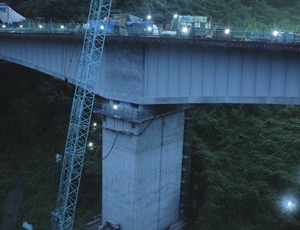
Six years after a Japanese construction company deployed a light-emitting-diode surveying system to collect continuous, three-dimensional positioning readings, researchers say the technology is now cheaper, easy-to-operate and an automated version of total station systems. It also performs in the dark or light 24 hours a day.
The work is the brainchild of Shinichiro Haruyama, professor at the Graduate School of System Design and Management at Keio University, Yokohama, Japan. Equipped with two Nikon D300 SLR cameras, 20 LED lights and a computer, Haruyama's team initially delivered an automated 3D profile feed of a 100- meter-long bridge in Nakaishiki in nearly real time as it was being constructed.
"We were able to measure the 3D position of the bridge within just a few millimeters of accuracy," he says. Haruyama set up his visible-light communication system by fixing two cameras at two different viewpoints parallel to the bridge. Both cameras' sensors could see the bridge and all the LED lights at once. The cameras simultaneously took rapid-fire bursts of one hundred 4,288- by 2,448-pixel images of the bridge. Every LED blinked in a unique pattern, which acted as an identifier. "By sending a pulse from an LED light, you can transfer data," says Haruyama. "The pulses act like binary code." The photos from both cameras were analyzed in a computer program, and every LED was pinpointed based on its blinking pattern. The software read the targets and triangulated the bridge's position. "The advantage of our method is that, once we set it up, we can automatically measure the positions all the time, so humans aren't needed," he says.
Haruyama says that, when setting up the system for the first time, his team does use total stations to get an accurate read on the bridge's position. From that point, any minute change is apparent through the LED system.
"It saves time, labor and money," says Naoki Nagamoto, an engineer for Sumitomo Mitsui Construction Co., Tokyo, who deployed Haruyama's system on the bridge. "We can measure over 50 points at once this way. If we use a total station, it may take more than two hours to get a read."
He says that, without the system, he would need two surveyors to take readings every other day. Using the automatic measurement system also reduces the chance of worker injury. "We set the LED targets one time, and we don't have to return to the dangerous positions again to measure," says Nagamoto.
The accuracy of the system is directly dependent on the pixel number of the camera, adds Nagamoto. "We used a 16-million-pixel camera at the Nakaishiki Bridge project, and its error [margin] was nearly equal to a total station." Cameras with more than 20 million pixels are readily available on the consumer market.
Nagamoto says that, since the construction of the bridge, he has used the LED system on many other construction sites, such as buildings and excavations, to monitor precise levels and positions. "We plan to use it as an automated landslide observation system, as well," he says. In that case, the LEDs would be constantly monitored; if the slightest land movement were to be detected, a warning would be sent out.
In his secondary role as chairman of the Visible Light Communications Consortium, Tokyo, Haruyama works with many Japanese companies that are trying to innovate around visible-light data-transfer technology. LEDs blink tens of thousands of times a second and can send a lot of data quickly, he says. Anything from music to wireless internet signals can be sent via blinking light in the on-off pattern of binary code, he observes.
Haruyama says the technology inspired him, but he wanted to use it for something more practical than beaming apps or songs from one device to another, so he turned to construction.


Post a comment to this article
Report Abusive Comment